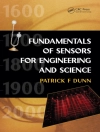This book reviews and showcases the design, fabrication and implementation of printed and flexible sensors and their range of applications. Since the use of flexible sensors has been demonstrated in almost every sector researchers are working towards optimization of present technologies and the implementation of new approaches, especially in light of developments emerging in printed and flexible electronics research. Some of the common issues faced and discussed include sensor stability in dynamic environments, non-availability of point-of-care devices, multifunctional sensing prototypes, requirement of high input power, saturation of sensitivity, difficulty in replacement of sensors operating in harsh real-time environments and need of biocompatible sensors for health monitoring.
Key Features
- Review of the various classes of printed flexible sensors and their applications
- Embraces fabrication and characterization methods.
- Included applications for biomedical, industrial and environmental sciences.
- Includes present challenges and future directions.
- Contributions by international experts in their respective fields.
Daftar Isi
Preface
1 Printed and flexible sensors: a review of products and techniques
2 Printed flexible sensors for academic research
3 Fabrication of printed flexible sensors: challenges and possible outcomes
4 Advances in printable devices for biomedical applications
5 Laser-induced graphene: advances in electro-biochemical sensing and energy application
6 Fabrication and applications of wearable microfluidic devices for Point-of-care sampling, manipulation, and testing
7 Single-wall carbon nanotube for flexible and printed electronics
8 Flexible strain sensors using graphene and its composites
9 Screen-printed electrochemical and impedance biosensors
10 Cellulose paper for flexible electronics; Design and Technology
11 Graphene-based implantable electrode for neural recording/stimulation
12 Screen-printed electrode-based sensor for biological and chemical species detection
13 3D printed enzymatic biofuel cell incorporated with graphene and modified graphite bioelectrodes: a comparative study
14 Development, simulation and characterization of a novel incontinence sensor system using 2D-printing technology with conductive polymer PEDOT:PSS
15 Flexible and transparent ‘self-adhesive’ thin-film strain, impact, force, pressure and temperature sensors: An experimental study
16 Fabrication and characterization of Ce O2 thin-film based oxygen sensors
17 Humidity detection in low ppm using printable flexible sensors
18 Printable and flexible sensor for droplet detection
19 Flexible and conformal antennas for wireless communication and sensing applications
Tentang Penulis
Subhas Mukhopadhyay holds B.E.E., M.E.E., Ph.D. and Doctor of Engineering degrees and has over 31 years of teaching, industrial and research experience. Currently, he is working as a Professor of Mechanical/Electronics Engineering, Macquarie University, Australia and is the Discipline Leader of the Mechatronics Engineering Degree Programme. He is also the Director of International Engagement for the School of Engineering. His fields of interest include Smart Sensors and sensing technology, instrumentation techniques, wireless sensors and network (WSN), Internet of Things (Io T), numerical field calculation, electromagnetics etc. He has published over 400 papers in international journals and conference proceedings, written nine books, forty-two book chapters, and edited seventeen conference proceedings. He is a Fellow of IEEE, a Fellow of IET, a Fellow of IETE and a member of the editorial boards of several journals, and the editor-in-chief of International Journal on Smart Sensing and Intelligent Systems.
Anindya Nag is an experienced Lecturer with a demonstrated history of working in the higher education industry. Skilled in the design, characterization, and implementation of MEMS-based and Flexible sensors using a range of microfabrication techniques like Photolithography, 3D printing, Laser Ablation, and others. He received my Doctor of Philosophy (Ph.D.) degree in Electrical and Electronics Engineering from Macquarie University.












